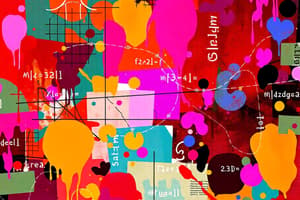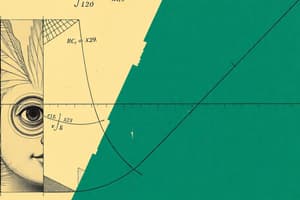Podcast
Questions and Answers
A water tank is being filled. The rate of water flow into the tank changes over time. Which calculus concept would be most useful for determining the total amount of water in the tank at a specific time?
A water tank is being filled. The rate of water flow into the tank changes over time. Which calculus concept would be most useful for determining the total amount of water in the tank at a specific time?
- Differential Calculus
- Derivatives
- Limits
- Integral Calculus (correct)
The position of a particle moving along a straight line is given by the function $s(t)$. What does the derivative, $s'(t)$, represent?
The position of a particle moving along a straight line is given by the function $s(t)$. What does the derivative, $s'(t)$, represent?
- The acceleration of the particle
- The velocity of the particle (correct)
- The total distance traveled by the particle
- The displacement of the particle
Which of the following geometric transformations does NOT preserve the size and shape of a figure?
Which of the following geometric transformations does NOT preserve the size and shape of a figure?
- Translation
- Reflection
- Rotation
- Dilation (correct)
In Euclidean geometry, if two lines are cut by a transversal such that the corresponding angles are congruent, what can be concluded?
In Euclidean geometry, if two lines are cut by a transversal such that the corresponding angles are congruent, what can be concluded?
What type of algebra is most directly used in the design and optimization of computer circuits?
What type of algebra is most directly used in the design and optimization of computer circuits?
How does the Fundamental Theorem of Calculus link differentiation and integration?
How does the Fundamental Theorem of Calculus link differentiation and integration?
In calculus, what is a 'limit' used to define?
In calculus, what is a 'limit' used to define?
Which of the following statements is true about non-Euclidean geometries?
Which of the following statements is true about non-Euclidean geometries?
Which geometric concept is most relevant when designing a bridge to ensure it can withstand various loads and stresses?
Which geometric concept is most relevant when designing a bridge to ensure it can withstand various loads and stresses?
You're given two matrices, A and B. Under what condition is the matrix multiplication AB defined?
You're given two matrices, A and B. Under what condition is the matrix multiplication AB defined?
A company wants to minimize production costs. Which calculus concept can be applied to find the minimum cost?
A company wants to minimize production costs. Which calculus concept can be applied to find the minimum cost?
In analytic geometry, what is used to represent geometric shapes?
In analytic geometry, what is used to represent geometric shapes?
Which of the following algebraic structures consists of a set with an operation that is associative, has an identity element, and every element has an inverse?
Which of the following algebraic structures consists of a set with an operation that is associative, has an identity element, and every element has an inverse?
How are logarithms related to exponential functions?
How are logarithms related to exponential functions?
What characterizes fractals in geometry?
What characterizes fractals in geometry?
A car's velocity is modeled by $v(t) = 3t^2 + 2t$. What calculus operation is used to find the total distance traveled over a time interval $[a, b]$?
A car's velocity is modeled by $v(t) = 3t^2 + 2t$. What calculus operation is used to find the total distance traveled over a time interval $[a, b]$?
If $\sin(\theta) = \frac{4}{5}$ in a right triangle, what is the value of $\cos(\theta)$?
If $\sin(\theta) = \frac{4}{5}$ in a right triangle, what is the value of $\cos(\theta)$?
Solve the following system of equations: $x + y = 5$ and $x - y = 1$. What is the value of $x$?
Solve the following system of equations: $x + y = 5$ and $x - y = 1$. What is the value of $x$?
A ladder is leaning against a wall, forming a right triangle. The ladder is 10 feet long, and the base of the ladder is 6 feet from the wall. How high up the wall does the ladder reach?
A ladder is leaning against a wall, forming a right triangle. The ladder is 10 feet long, and the base of the ladder is 6 feet from the wall. How high up the wall does the ladder reach?
What is the binomial expansion of $(x + 2)^3$?
What is the binomial expansion of $(x + 2)^3$?
Flashcards
What is Calculus?
What is Calculus?
The study of continuous change, rates, and motion.
What is Differential Calculus?
What is Differential Calculus?
Deals with instantaneous rates of change and slopes of curves.
What is Integral Calculus?
What is Integral Calculus?
Concerns the accumulation of quantities and areas under curves.
What is the derivative of a function?
What is the derivative of a function?
Signup and view all the flashcards
What is Integration?
What is Integration?
Signup and view all the flashcards
What is the Fundamental Theorem of Calculus?
What is the Fundamental Theorem of Calculus?
Signup and view all the flashcards
What are Optimization problems?
What are Optimization problems?
Signup and view all the flashcards
What is Multivariable Calculus?
What is Multivariable Calculus?
Signup and view all the flashcards
What is Geometry?
What is Geometry?
Signup and view all the flashcards
What is Euclidean Geometry?
What is Euclidean Geometry?
Signup and view all the flashcards
What is Analytic Geometry?
What is Analytic Geometry?
Signup and view all the flashcards
What is Trigonometry?
What is Trigonometry?
Signup and view all the flashcards
What is the Pythagorean Theorem?
What is the Pythagorean Theorem?
Signup and view all the flashcards
What is Topology?
What is Topology?
Signup and view all the flashcards
What are Fractals?
What are Fractals?
Signup and view all the flashcards
What is Algebra?
What is Algebra?
Signup and view all the flashcards
What is a Linear Equation?
What is a Linear Equation?
Signup and view all the flashcards
What is a Quadratic Equation?
What is a Quadratic Equation?
Signup and view all the flashcards
What are Matrices?
What are Matrices?
Signup and view all the flashcards
What are Logarithms?
What are Logarithms?
Signup and view all the flashcards
Study Notes
- Math encompasses a broad range of topics, including number theory, algebra, geometry, and calculus.
- It involves the study of quantities, structures, spaces, and changes.
Calculus
- Calculus is the study of continuous change, analogous to how geometry is the study of shape and algebra is the study of generalizations of arithmetic operations.
- It has two major branches, differential calculus and integral calculus.
- Differential calculus concerns instantaneous rates of change and the slopes of curves.
- Integral calculus concerns accumulation of quantities and the areas under and between curves.
- Calculus is used extensively in science, engineering, and economics.
- It is used to model situations where rates of change are important.
- The derivative of a function at a point gives the slope of the tangent line at that point.
- Integration is the reverse process of differentiation.
- The definite integral of a function over an interval gives the area between the curve and the x-axis.
- The fundamental theorem of calculus links differentiation and integration.
- Limits are a foundational concept in calculus, used to define derivatives and integrals.
- A limit describes the value that a function approaches as the input approaches some value.
- Calculus is essential for solving optimization problems.
- It can be used to find maximum and minimum values of functions.
- Multivariable calculus extends the concepts of calculus to functions of multiple variables.
Geometry
- Geometry is concerned with the properties and relations of points, lines, surfaces, solids, and higher dimensional analogs.
- Euclidean geometry is based on a set of axioms formulated by Euclid.
- It deals with concepts like points, lines, angles, and shapes in a two-dimensional plane or three-dimensional space.
- Non-Euclidean geometries include hyperbolic and elliptic geometry, which do not assume Euclid's parallel postulate.
- Analytic geometry uses algebra to study geometric shapes, using coordinate systems to represent points and equations to represent lines and curves.
- Trigonometry deals with the relationships between the sides and angles of triangles.
- It is used extensively in surveying, navigation, and physics.
- Key trigonometric functions include sine, cosine, and tangent.
- Pythagorean theorem relates the sides of a right triangle: a² + b² = c².
- Geometry is used to calculate areas, volumes, and surface areas of various shapes.
- Transformations such as translations, rotations, reflections, and dilations are studied in geometry.
- Topology is a branch of geometry that studies properties that are preserved under continuous deformations, such as stretching or bending.
- Fractals are complex geometric shapes with self-similar patterns at different scales.
Algebra
- Algebra is a branch of mathematics that deals with symbols and the rules for manipulating those symbols.
- It is a generalization of arithmetic.
- Elementary algebra involves solving equations with variables.
- Linear equations can be written in the form ax + b = 0, where x is the variable to be solved.
- Quadratic equations can be written in the form ax² + bx + c = 0 and can be solved using the quadratic formula.
- Systems of equations involve two or more equations with the same variables, and the goal is to find the values of the variables that satisfy all equations.
- Abstract algebra deals with algebraic structures such as groups, rings, and fields.
- These structures are defined by a set of elements and operations that satisfy certain axioms.
- Boolean algebra deals with logical operations, and it is fundamental to computer science.
- Matrices are rectangular arrays of numbers, and they are used to represent linear transformations and solve systems of equations.
- Vectors are mathematical objects that have both magnitude and direction.
- They are used extensively in physics and engineering.
- Polynomials are expressions consisting of variables and coefficients, combined using addition, subtraction, and multiplication.
- The binomial theorem describes the expansion of powers of binomials.
- Logarithms are the inverse of exponential functions.
- They are used to solve equations where the variable is in the exponent.
Studying That Suits You
Use AI to generate personalized quizzes and flashcards to suit your learning preferences.




